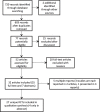Endoscopic and Open Release Similarly Safe for the Treatment of Carpal Tunnel Syndrome. A Systematic Review and Meta-Analysis
- PMID: 26674211
- PMCID: PMC4682940
- DOI: 10.1371/journal.pone.0143683
Endoscopic and Open Release Similarly Safe for the Treatment of Carpal Tunnel Syndrome. A Systematic Review and Meta-Analysis
Abstract
Background: The Endoscopic Release of Carpal Tunnel Syndrome (ECTR) is a minimal invasive approach for the treatment of Carpal Tunnel Syndrome. There is scepticism regarding the safety of this technique, based on the assumption that this is a rather "blind" procedure and on the high number of severe complications that have been reported in the literature.
Purpose: To evaluate whether there is evidence supporting a higher risk after ECTR in comparison to the conventional open release.
Methods: We searched MEDLINE (January 1966 to November 2013), EMBASE (January 1980 to November 2013), the Cochrane Neuromuscular Disease Group Specialized Register (November 2013) and CENTRAL (2013, issue 11 in The Cochrane Library). We hand-searched reference lists of included studies. We included all randomized or quasi-randomized controlled trials (e.g. study using alternation, date of birth, or case record number) that compare any ECTR with any OCTR technique. Safety was assessed by the incidence of major, minor and total number of complications, recurrences, and re-operations.The total time needed before return to work or to return to daily activities was also assessed. We synthesized data using a random-effects meta-analysis in STATA. We conducted a sensitivity analysis for rare events using binomial likelihood. We judged the conclusiveness of meta-analysis calculating the conditional power of meta-analysis.
Conclusions: ECTR is associated with less time off work or with daily activities. The assessment of major complications, reoperations and recurrence of symptoms does not favor either of the interventions. There is an uncertain advantage of ECTR with respect to total minor complications (more transient paresthesia but fewer skin-related complications). Future studies are unlikely to alter these findings because of the rarity of the outcome. The effect of a learning curve might be responsible for reduced recurrences and reoperations with ECTR in studies that are more recent, although formal statistical analysis failed to provide evidence for such an association.
Level of evidence: I.
Conflict of interest statement
Figures




Similar articles
-
Absorbable versus non-absorbable sutures for skin closure after carpal tunnel decompression surgery.Cochrane Database Syst Rev. 2018 Feb 1;2(2):CD011757. doi: 10.1002/14651858.CD011757.pub2. Cochrane Database Syst Rev. 2018. PMID: 29390170 Free PMC article.
-
Systemic pharmacological treatments for chronic plaque psoriasis: a network meta-analysis.Cochrane Database Syst Rev. 2017 Dec 22;12(12):CD011535. doi: 10.1002/14651858.CD011535.pub2. Cochrane Database Syst Rev. 2017. Update in: Cochrane Database Syst Rev. 2020 Jan 9;1:CD011535. doi: 10.1002/14651858.CD011535.pub3. PMID: 29271481 Free PMC article. Updated.
-
Antidepressants for pain management in adults with chronic pain: a network meta-analysis.Health Technol Assess. 2024 Oct;28(62):1-155. doi: 10.3310/MKRT2948. Health Technol Assess. 2024. PMID: 39367772 Free PMC article.
-
Systemic pharmacological treatments for chronic plaque psoriasis: a network meta-analysis.Cochrane Database Syst Rev. 2021 Apr 19;4(4):CD011535. doi: 10.1002/14651858.CD011535.pub4. Cochrane Database Syst Rev. 2021. Update in: Cochrane Database Syst Rev. 2022 May 23;5:CD011535. doi: 10.1002/14651858.CD011535.pub5. PMID: 33871055 Free PMC article. Updated.
-
Rehabilitation for ankle fractures in adults.Cochrane Database Syst Rev. 2024 Sep 23;9(9):CD005595. doi: 10.1002/14651858.CD005595.pub4. Cochrane Database Syst Rev. 2024. PMID: 39312389
Cited by
-
Patient Willingness to Pay for Faster Return to Work or Smaller Incisions.Hand (N Y). 2021 Nov;16(6):811-817. doi: 10.1177/1558944719890039. Epub 2019 Dec 2. Hand (N Y). 2021. PMID: 31791156 Free PMC article.
-
Incidence of Nerve Repair Following Endoscopic Carpal Tunnel Release Is Higher Compared to Open Release in New York State.HSS J. 2019 Jul;15(2):143-146. doi: 10.1007/s11420-018-9637-1. Epub 2018 Nov 27. HSS J. 2019. PMID: 31327945 Free PMC article.
-
Quality analysis of prior systematic reviews of carpal tunnel syndrome: an overview of the literature.Sao Paulo Med J. 2022 Dec 19;141(5):e20211020. doi: 10.1590/1516-3180.2021.1020.R2.10102022. eCollection 2022. Sao Paulo Med J. 2022. PMID: 36541951 Free PMC article.
-
A comparative study on efficacy of modified endoscopic minimally invasive treatment and traditional open surgery for primary carpal tunnel syndrome.J Orthop Surg Res. 2023 Jul 18;18(1):511. doi: 10.1186/s13018-023-03927-x. J Orthop Surg Res. 2023. PMID: 37464402 Free PMC article.
-
Carpal Tunnel Syndrome Surgery: What You Should Know.Plast Reconstr Surg Glob Open. 2020 Mar 20;8(3):e2692. doi: 10.1097/GOX.0000000000002692. eCollection 2020 Mar. Plast Reconstr Surg Glob Open. 2020. PMID: 32537349 Free PMC article. Review.
References
-
- Chow JC. Endoscopic release of the carpal ligament: a new technique for carpal tunnel syndrome. Arthroscopy. 1989;5: 19–24. - PubMed
-
- Okutsu I, Ninomiya S, Takatori Y, Ugawa Y. Endoscopic management of carpal tunnel syndrome. Arthroscopy. 1989;5: 11–18. - PubMed
-
- Boeckstyns ME, Sorensen AI. Does endoscopic carpal tunnel release have a higher rate of complications than open carpal tunnel release? An analysis of published series. JHand SurgBr. 1999;24: 9–15. - PubMed
-
- Bozentka DJ, Osterman AL. Complications of endoscopic carpal tunnel release. Hand Clin. 1995;11: 91–95. - PubMed
-
- Shinya K, Lanzetta M, Conolly WB. Risk and complications in endoscopic carpal tunnel release. JHand SurgBr. 1995;20: 222–227. - PubMed
Publication types
MeSH terms
LinkOut - more resources
Full Text Sources
Other Literature Sources
Medical
Research Materials

